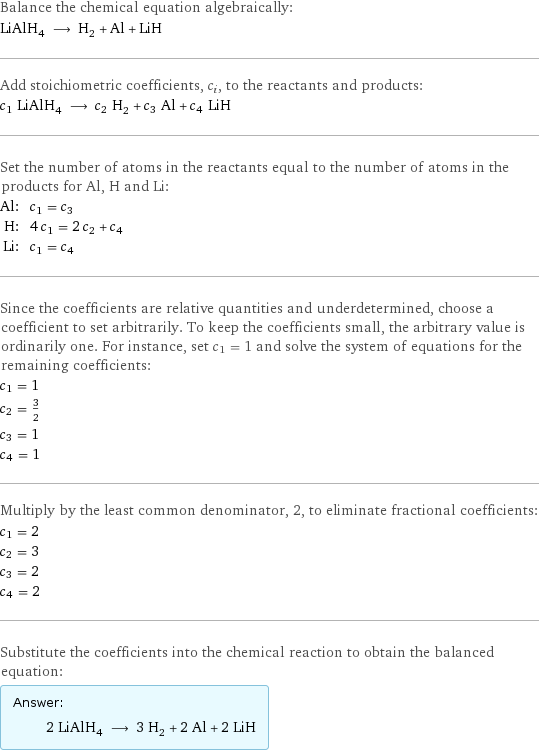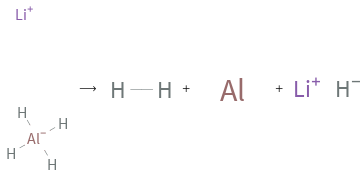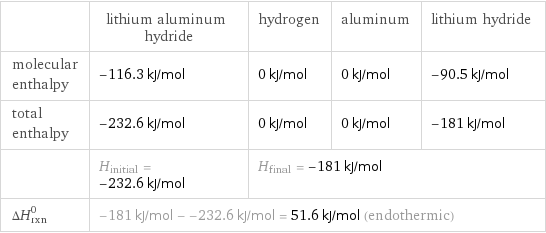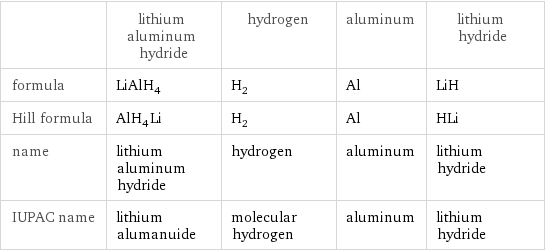Input interpretation

LiAlH_4 lithium aluminum hydride ⟶ H_2 hydrogen + Al aluminum + LiH lithium hydride
Balanced equation

Balance the chemical equation algebraically: LiAlH_4 ⟶ H_2 + Al + LiH Add stoichiometric coefficients, c_i, to the reactants and products: c_1 LiAlH_4 ⟶ c_2 H_2 + c_3 Al + c_4 LiH Set the number of atoms in the reactants equal to the number of atoms in the products for Al, H and Li: Al: | c_1 = c_3 H: | 4 c_1 = 2 c_2 + c_4 Li: | c_1 = c_4 Since the coefficients are relative quantities and underdetermined, choose a coefficient to set arbitrarily. To keep the coefficients small, the arbitrary value is ordinarily one. For instance, set c_1 = 1 and solve the system of equations for the remaining coefficients: c_1 = 1 c_2 = 3/2 c_3 = 1 c_4 = 1 Multiply by the least common denominator, 2, to eliminate fractional coefficients: c_1 = 2 c_2 = 3 c_3 = 2 c_4 = 2 Substitute the coefficients into the chemical reaction to obtain the balanced equation: Answer: | | 2 LiAlH_4 ⟶ 3 H_2 + 2 Al + 2 LiH
Structures

⟶ + +
Names

lithium aluminum hydride ⟶ hydrogen + aluminum + lithium hydride
Reaction thermodynamics
Enthalpy

| lithium aluminum hydride | hydrogen | aluminum | lithium hydride molecular enthalpy | -116.3 kJ/mol | 0 kJ/mol | 0 kJ/mol | -90.5 kJ/mol total enthalpy | -232.6 kJ/mol | 0 kJ/mol | 0 kJ/mol | -181 kJ/mol | H_initial = -232.6 kJ/mol | H_final = -181 kJ/mol | | ΔH_rxn^0 | -181 kJ/mol - -232.6 kJ/mol = 51.6 kJ/mol (endothermic) | | |
Equilibrium constant
![Construct the equilibrium constant, K, expression for: LiAlH_4 ⟶ H_2 + Al + LiH Plan: • Balance the chemical equation. • Determine the stoichiometric numbers. • Assemble the activity expression for each chemical species. • Use the activity expressions to build the equilibrium constant expression. Write the balanced chemical equation: 2 LiAlH_4 ⟶ 3 H_2 + 2 Al + 2 LiH Assign stoichiometric numbers, ν_i, using the stoichiometric coefficients, c_i, from the balanced chemical equation in the following manner: ν_i = -c_i for reactants and ν_i = c_i for products: chemical species | c_i | ν_i LiAlH_4 | 2 | -2 H_2 | 3 | 3 Al | 2 | 2 LiH | 2 | 2 Assemble the activity expressions accounting for the state of matter and ν_i: chemical species | c_i | ν_i | activity expression LiAlH_4 | 2 | -2 | ([LiAlH4])^(-2) H_2 | 3 | 3 | ([H2])^3 Al | 2 | 2 | ([Al])^2 LiH | 2 | 2 | ([LiH])^2 The equilibrium constant symbol in the concentration basis is: K_c Mulitply the activity expressions to arrive at the K_c expression: Answer: | | K_c = ([LiAlH4])^(-2) ([H2])^3 ([Al])^2 ([LiH])^2 = (([H2])^3 ([Al])^2 ([LiH])^2)/([LiAlH4])^2](../image_source/c3e8ffceea29acb9bf487be82a7292be.png)
Construct the equilibrium constant, K, expression for: LiAlH_4 ⟶ H_2 + Al + LiH Plan: • Balance the chemical equation. • Determine the stoichiometric numbers. • Assemble the activity expression for each chemical species. • Use the activity expressions to build the equilibrium constant expression. Write the balanced chemical equation: 2 LiAlH_4 ⟶ 3 H_2 + 2 Al + 2 LiH Assign stoichiometric numbers, ν_i, using the stoichiometric coefficients, c_i, from the balanced chemical equation in the following manner: ν_i = -c_i for reactants and ν_i = c_i for products: chemical species | c_i | ν_i LiAlH_4 | 2 | -2 H_2 | 3 | 3 Al | 2 | 2 LiH | 2 | 2 Assemble the activity expressions accounting for the state of matter and ν_i: chemical species | c_i | ν_i | activity expression LiAlH_4 | 2 | -2 | ([LiAlH4])^(-2) H_2 | 3 | 3 | ([H2])^3 Al | 2 | 2 | ([Al])^2 LiH | 2 | 2 | ([LiH])^2 The equilibrium constant symbol in the concentration basis is: K_c Mulitply the activity expressions to arrive at the K_c expression: Answer: | | K_c = ([LiAlH4])^(-2) ([H2])^3 ([Al])^2 ([LiH])^2 = (([H2])^3 ([Al])^2 ([LiH])^2)/([LiAlH4])^2
Rate of reaction
![Construct the rate of reaction expression for: LiAlH_4 ⟶ H_2 + Al + LiH Plan: • Balance the chemical equation. • Determine the stoichiometric numbers. • Assemble the rate term for each chemical species. • Write the rate of reaction expression. Write the balanced chemical equation: 2 LiAlH_4 ⟶ 3 H_2 + 2 Al + 2 LiH Assign stoichiometric numbers, ν_i, using the stoichiometric coefficients, c_i, from the balanced chemical equation in the following manner: ν_i = -c_i for reactants and ν_i = c_i for products: chemical species | c_i | ν_i LiAlH_4 | 2 | -2 H_2 | 3 | 3 Al | 2 | 2 LiH | 2 | 2 The rate term for each chemical species, B_i, is 1/ν_i(Δ[B_i])/(Δt) where [B_i] is the amount concentration and t is time: chemical species | c_i | ν_i | rate term LiAlH_4 | 2 | -2 | -1/2 (Δ[LiAlH4])/(Δt) H_2 | 3 | 3 | 1/3 (Δ[H2])/(Δt) Al | 2 | 2 | 1/2 (Δ[Al])/(Δt) LiH | 2 | 2 | 1/2 (Δ[LiH])/(Δt) (for infinitesimal rate of change, replace Δ with d) Set the rate terms equal to each other to arrive at the rate expression: Answer: | | rate = -1/2 (Δ[LiAlH4])/(Δt) = 1/3 (Δ[H2])/(Δt) = 1/2 (Δ[Al])/(Δt) = 1/2 (Δ[LiH])/(Δt) (assuming constant volume and no accumulation of intermediates or side products)](../image_source/b913c325e77c0ffc300cb36b17dd7d4a.png)
Construct the rate of reaction expression for: LiAlH_4 ⟶ H_2 + Al + LiH Plan: • Balance the chemical equation. • Determine the stoichiometric numbers. • Assemble the rate term for each chemical species. • Write the rate of reaction expression. Write the balanced chemical equation: 2 LiAlH_4 ⟶ 3 H_2 + 2 Al + 2 LiH Assign stoichiometric numbers, ν_i, using the stoichiometric coefficients, c_i, from the balanced chemical equation in the following manner: ν_i = -c_i for reactants and ν_i = c_i for products: chemical species | c_i | ν_i LiAlH_4 | 2 | -2 H_2 | 3 | 3 Al | 2 | 2 LiH | 2 | 2 The rate term for each chemical species, B_i, is 1/ν_i(Δ[B_i])/(Δt) where [B_i] is the amount concentration and t is time: chemical species | c_i | ν_i | rate term LiAlH_4 | 2 | -2 | -1/2 (Δ[LiAlH4])/(Δt) H_2 | 3 | 3 | 1/3 (Δ[H2])/(Δt) Al | 2 | 2 | 1/2 (Δ[Al])/(Δt) LiH | 2 | 2 | 1/2 (Δ[LiH])/(Δt) (for infinitesimal rate of change, replace Δ with d) Set the rate terms equal to each other to arrive at the rate expression: Answer: | | rate = -1/2 (Δ[LiAlH4])/(Δt) = 1/3 (Δ[H2])/(Δt) = 1/2 (Δ[Al])/(Δt) = 1/2 (Δ[LiH])/(Δt) (assuming constant volume and no accumulation of intermediates or side products)
Chemical names and formulas

| lithium aluminum hydride | hydrogen | aluminum | lithium hydride formula | LiAlH_4 | H_2 | Al | LiH Hill formula | AlH_4Li | H_2 | Al | HLi name | lithium aluminum hydride | hydrogen | aluminum | lithium hydride IUPAC name | lithium alumanuide | molecular hydrogen | aluminum | lithium hydride
Substance properties

| lithium aluminum hydride | hydrogen | aluminum | lithium hydride molar mass | 37.95 g/mol | 2.016 g/mol | 26.9815385 g/mol | 7.95 g/mol phase | solid (at STP) | gas (at STP) | solid (at STP) | solid (at STP) melting point | 125 °C | -259.2 °C | 660.4 °C | 680 °C boiling point | | -252.8 °C | 2460 °C | density | 0.91 g/cm^3 | 8.99×10^-5 g/cm^3 (at 0 °C) | 2.7 g/cm^3 | 0.82 g/cm^3 solubility in water | decomposes | | insoluble | reacts surface tension | | | 0.817 N/m | dynamic viscosity | | 8.9×10^-6 Pa s (at 25 °C) | 1.5×10^-4 Pa s (at 760 °C) | odor | odorless | odorless | odorless |
Units
